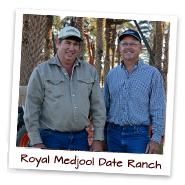Preventing Shaker Damage in Almonds
By Patrick Cavanaugh, Editor
 |
|
David Doll, UC Cooperative Extension
Farm Advisor, Merced County.
|
 |
|
David Doll, UC Cooperative Extension
Farm Advisor, Merced County.
|
 |
| Ranch Managers Ron Hill, left and Steve McCollum |
 “The Nonpareils are going like crazy,” said Vern Crawford, a long-time PCA for Wilbur-Ellis Co., Shafter Branch. “With the crop estimate down, prices are up, and that’s good since growers had to spend so much on mite sprays this year.”
“The Nonpareils are going like crazy,” said Vern Crawford, a long-time PCA for Wilbur-Ellis Co., Shafter Branch. “With the crop estimate down, prices are up, and that’s good since growers had to spend so much on mite sprays this year.”
By Patrick Cavanaugh, Editor
BY LAURIE GREENE, ASSOCIATE EDITOR
.jpg) Plant physiologist Gayle Volk of the Agricultural Research Service (ARS) is applying the procedure to create a long-term genebank for important citrus varieties, breeding lines and wild citrus species. These efforts coincide with concern over the spread of citrus greening, an insect-borne disease first detected in the U.S. in August 2005, has been found in California, and which now threatens the nation’s citrus crop, valued at $3.4 billion in 2011-12.
Plant physiologist Gayle Volk of the Agricultural Research Service (ARS) is applying the procedure to create a long-term genebank for important citrus varieties, breeding lines and wild citrus species. These efforts coincide with concern over the spread of citrus greening, an insect-borne disease first detected in the U.S. in August 2005, has been found in California, and which now threatens the nation’s citrus crop, valued at $3.4 billion in 2011-12.
for the Sacramento River hydrologic region, where most of the state’s rain occurs.
– the source of much of our water supply. The eight stations are:
Blue Canyon, Brush Creek Ranger Station, Mineral, Mount Shasta City, Pacific House, Quincy Ranger Station, Shasta Dam, and Sierraville Ranger Station.
this index, including snowpack and prior streamflow. And yes, the
seasonal forecasts are a more accurate measure of water supply, but great consideration must be made to the nearly one million acre-feet released to the ocean last winter for “flood control” instead of to storage. This is due to the biological opinion that restricts turning on the pumps that move the water to storage.